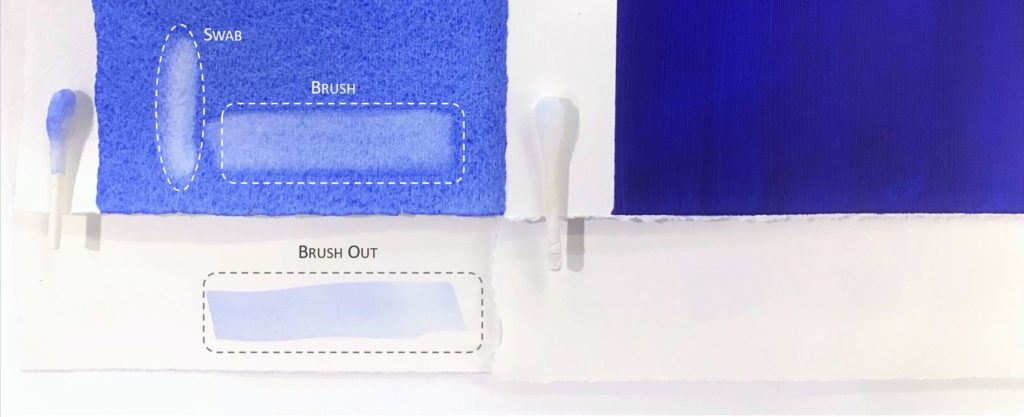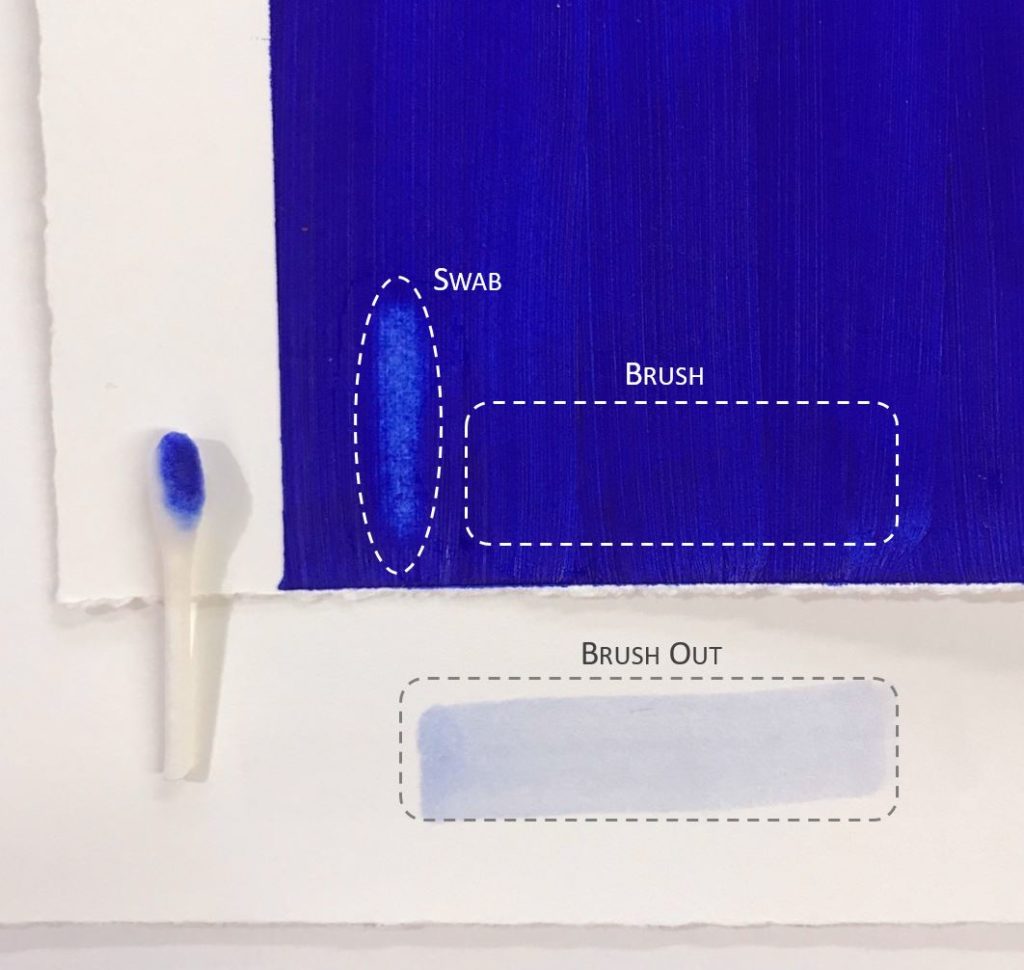Artists enjoy working with many different types of media on a variety of unique surfaces and while we at GOLDEN try our best to test many of the materials available to artists, we are unable to test them all. Being able to test for inherent sensitivities to water or solvents within art materials, for example, can provide valuable insight into how certain materials may behave when layered together. In this article, we hope to offer a simple method of testing for sensitivity that can be done by artists at home. We also hope to illustrate the value of such testing and simultaneously reaffirm, through sensitivity testing, our recommendation for using our Isolation Coat as an integral part of the varnishing process.
How to Perform The Test
In an ideal scenario, an artist will test any materials they have questions about before using them in order to avoid potential mishaps or setbacks during the artistic process. Of course that degree of foresight is not always possible, but having more knowledge allows artists to make choices as to what materials they use and how they use them. It also gives them the opportunity to reduce sensitivities when possible so that they maintain the integrity of the artwork they are creating. Correcting after the fact can be extremely difficult if not impossible, so a little planning goes a long way.
The test itself is simple and we will show two methods that illustrate different degrees of aggressiveness. The much harsher test requires the use of a household cotton swab (Q-Tip®), while a gentler test can be performed with a small soft synthetic brush. Depending upon the artist, one may be a better representation of their working methods and preferable over another.

To do the test, we recommend first finding a discreet location on the surface you are testing, or better yet, create a separate test piece with the same materials you will ultimately be using. If you are testing water sensitivity, for example, moisten the tip of the cotton swab with water and while using consistent pressure, swipe back and forth over the surface ten times in a small area. The same process can be followed with a brush, where the contents of the brush are then painted out on a scrap piece of paper. If there is sensitivity, evidence will be visible on the cotton swab in the form of color lift or on the painted scrap of paper from the brush out. If there is no evidence of lift, the surface does not exhibit sensitivity.
While the water sensitivity of watercolor is understood as a feature of the medium, it clearly illustrates this test. More broadly, knowing whether or not a medium is water sensitive is important when considering how a piece is displayed, what type of varnish would be appropriate, or which materials or processes you can use in making your artwork.
For more information on varnishing watercolors, refer to our Just Paint Article, GOLDEN Archival MSA Varnish Over Transparent Watercolor on Paper.
Examples of Sensitivity Testing
Water Sensitivity

In the above example, we compare both QoR Watercolor and GOLDEN Heavy Body Acrylic Ultramarine Blue to demonstrate the difference in sensitivity of both mediums to water. It is clear from the test that acrylics exhibit less water sensitivity than watercolor, which serves to illustrate how different binders can exhibit different characteristics or sensitivities.
For more extensive water sensitivity testing on acrylic layers with different additions of water, please check out our Just Paint article How Much Water Can You Safely Add to Acrylic Paint?.
Alcohol Sensitivity on Acrylics

To push this a step farther, we repeated the same sensitivity test on Heavy Body Ultramarine Blue, but instead of water we used 70% isopropyl alcohol. The results demonstrate the sensitivity of acrylics to alcohol. This is something to be mindful of if you are layering alcohol inks over acrylics, for example, or you are attempting to clean an acrylic painting with a household cleaning product that may have an alcohol component, which is not something we recommend. This sensitivity also has some advantages, however, by acting as a solvent for the acrylics.
For more alcohol sensitivity testing results on a variety of drawing media, please check out our Just Paint Article: Make a Mark
As a nice companion piece to Make a Mark, we show even more sensitivity testing of India Inks as a drawing medium to acrylic paints and mediums as well as shellac-based primers, in our Just Paint Article Waterproof India Inks and Shellac-based Primers
Solvent Sensitivity
Prior to varnishing it is also useful to know if a painting or mixed media piece is sensitive to the solvent within a particular varnish or the solvent used for varnish removal. In the image below, we tested Fluid Quinacridone Magenta for sensitivities to water, full strength mineral spirits (MSA Solvent), and household ammonia. The solvents for our MSA Varnish, Polymer Varnish and the solvent used in the removal of Polymer Varnish. On the top row, sensitivity testing was performed directly over the Quinacridone Magenta and on the bottom row an isolation coat was applied over the Quinacridone Magenta prior to testing.

As evidenced by the results, paint was only removed by the more aggressive cotton swab when tested directly over the paint, which shows that both brush and spray applications of varnish should be possible. When tested over an isolation coat there was no evidence of lift, which shows just how important an isolation coat can be to the varnish process. Not only does the isolation coat reduce risk of color lift or smearing during varnish application, it adds additional protection in the event a varnish is ever removed for cleaning or conservation purposes. If a particular color or media proves to be very sensitive when tested, showing signs of pigment lift, spray application of a varnish may still be an option.
More information on Isolation Coats can be found here.
Water Sensitivity Testing on Photo Prints
Print technologies have continued to improve over time and the number of ink receptive substrates and colorant systems available to artists has broadened. While in our testing we have noticed improvements in the water sensitivity of inkjet prints, for example, we still believe testing to be of paramount importance. Due to variability between the type of products and printing systems out there, artists should not expect them all to perform similarly. Additionally, depending upon the application, a thicker gel with a longer open time could affect a print that shows minimal water sensitivity or is marketed as a waterproof. Testing using an application similar to what is intended can be useful.
For more information on using GOLDEN products on prints, refer to our Just Paint Article GAC Products on Inkjet Prints
When Is It Important to Test for Sensitivity?
The best reason to test for sensitivity is when you are using a material or performing an application where it is unknown how a surface or material will react. For some of us this happens naturally through a process of trial and error as we work, while for others, knowing in advance can save time, money and frustration. Hopefully, this simple process can assist artists in gaining more information about their materials so they are better equipped to make sound artistic decisions.
If you have any questions or comments about this article or any other paint related topic, please feel free to contact our Materials Application Department at [email protected] or by calling 800-959-6543.
About Scott Fischer
View all posts by Scott Fischer -->Subscribe
Subscribe to the newsletter today!
No related Post

1 thought on “Testing for Sensitivity”